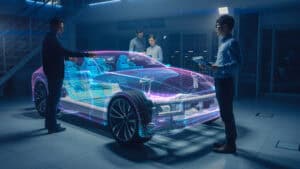
By embracing a generative design methodology, automotive companies can navigate the complexity of EV development, improve design performance, and speed innovation.
As the market for electric vehicles (EVs) evolves, startups and legacy players face mounting pressure to deliver high-performance, feature-rich, and safe vehicles to market faster than ever before. Yet, in addition to the mechanical challenges of designing internal combustion engine (ICE) cars, EVs have a major electrical component that requires new design methods. Increasingly, EV automakers are exploring generative design to address these issues.
Why? The complexity of electric powertrains, advanced driver assistance systems (ADAS), infotainment, and safety-critical electronics is outpacing conventional engineering workflows. Generative design offers help in that it provides a rules-based, automation-driven methodology that promises to streamline EV electrical system design.
Why EV Design Is Reaching a Tipping Point
Modern vehicles are already packed with sophisticated electronic systems. From touchscreen dashboards to intelligent sensors managing steering and throttle, electrical systems are integral to today’s driving experience. EVs take this reliance on electronics even further, where every function is electrically powered, from propulsion to air conditioning.
The proliferation of electronics dramatically increases power consumption. Unlike hybrid models that have the fallback of an ICE to help recharge batteries, fully electric vehicles rely solely on stored battery energy. Every sensor, every display, and every line of code matters because they directly impact vehicle range and performance.
For EV manufacturers, this raises the stakes. It’s not enough to simply layer new technologies onto legacy designs. Electrical and electronic (E/E) architectures must be reimagined from the ground up. Specifically, they must be optimized for efficiency, cost, weight, and compliance. Those are all areas where generative design can help.
See also: Balancing Speed and Quality in Compressed Automotive Timelines
What Is Generative Design?
Generative design is an intelligent, automated approach to engineering where system requirements and constraints are used as inputs to generate optimized architectural proposals for logic, hardware, software, and networks. Some say this is akin to a digital design assistant that applies years of engineering know-how and rules to generate solutions that humans might not easily see. It does this faster and with greater accuracy than if done by a human alone.
At the heart of generative design is rules-based automation, which codifies institutional knowledge and applies it consistently. Existing engineering practices are embedded into every stage of the design process, guiding even junior engineers to produce robust, optimized systems. That leads to a democratization of expertise, which is vital in a fast-evolving landscape where talent and time are in short supply.
How Generative Design Works
Generative design begins with a functional model, which is an abstract representation of the E/E system’s intended behavior. These models may come from various formats like SysML diagrams, spreadsheets, or Visio files. These diverse inputs are then normalized within an electrical systems design environment.
Once normalized, engineers can generate multiple design proposals that automatically integrate key design rules. These proposals cover everything from power networks to ECU (Electronic Control Unit) placements and signal routes. The team can then assess and compare different architectures, selecting the one that best balances performance, weight, cost, and compliance.
From there, the design flow extends to wire harness design, manufacturing documentation, and even VIN-specific service manuals, creating a seamless pipeline from concept to service.
Solving the Real-World Challenges of EV Production
Transitioning from one-off prototypes to mass-produced electric vehicles presents a host of challenges. Manufacturers must scale their designs while meeting stringent safety standards and controlling costs. Generative design addresses these issues in several ways, including:
- Design in Platform Context: Generative tools allow engineers to consider the full vehicle platform, minimizing interface errors and wiring conflicts across subsystems.
- Speed and Agility: Automation accelerates development without sacrificing quality, reducing the risk of late-stage redesigns.
- Cross-Domain Integration: Electrical systems don’t exist in a vacuum. Generative design platforms integrate with mechanical and software tools, allowing for real-time collaboration and data continuity across domains.
Such an approach is especially valuable when changes occur. For example, moving an ECU may impact network latency or signal integrity. Generative design environments support comprehensive impact analysis, showing how one change cascades through the system—something traditional methods struggle to do efficiently.
One of the most underappreciated aspects of generative design is the single source of truth it creates. Every design element is traceable and version controlled, from initial system definitions to production and service documentation. This continuity ensures that all teams are working with the latest, validated data and that compliance with safety and certification standards can be demonstrated at every step.
Design rule checks built into the environment flag common and costly mistakes—like unterminated wires or inconsistent bundle lengths—before they reach the prototype phase. This results in better first-time quality and dramatically reduces the need for rework.
A Strategic Advantage for the EV Race
The race to lead the EV market is not just about performance specs or charging range. It’s about who can manage complexity the best while delivering innovative, reliable, and scalable products. Generative design offers a strategic edge by:
- Capturing and applying expert knowledge automatically
- Accelerating development through intelligent automation
- Ensuring traceability and compliance with industry standards
- Allowing efficient reuse of validated designs across platforms
- Enabling cross-domain collaboration and data sharing
For startups, this means achieving OEM-grade design quality without a massive team of senior engineers. For established automakers, it means staying agile and competitive in a market that no longer rewards slow iteration.
These capabilities are essential as the EV industry matures and the demands on electrical systems intensify. New vehicles will host more sensors, more ECUs, and more miles of wiring. With greater connectivity, cybersecurity needs, and autonomous driving features on the horizon, generative design is quickly becoming a necessity.
By embracing a generative design methodology, automotive companies can navigate the complexity of EV development, improve design performance, and speed innovation.






